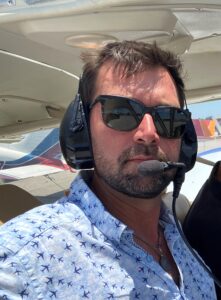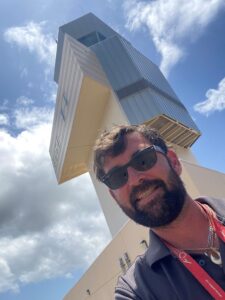
For Civil Engineer Kyle Holley, building a safer airport is not as glamorous as perhaps an architect, but it is just as important. Chances are everything that you do not see but everything a plane touches a civil engineer is responsible for.
Holley originally grew up in Alabama and achieved his degree in civil engineering at Auburn University. Holley’s first job after college was with an aviation design firm and that’s how he got into the aviation specialty field. He began working with American Infrastructure Development 10 years ago and shortly after when they opened an office on St. Croix, he relocated and resided locally since 2016 for the terminal’s rehab.
When approaching a project, Holley said that most important is talking to all the stakeholders and all the people involved. “It’s a relatively simple step but we think it’s the most important. For an airfield project for example we go out and we talk to the maintenance operation, the maintenance crew, and the airfield electricians. They are going to know best what their needs are for their airfield because they live and work there every day.”
Holley said it’s gaining the information from the people involved and then on the flip side it’s talking to the stakeholders if it’s something to do with the terminals or the gates. “You talk to the airlines and get them involved early in the process. Really communication is the best thing to approach a project in the early stage,” said Holley.
Holley has worked as the project manager and engineer and his approach is adaptive. He focuses on developing the best engineering solution for each individual project.

“The number one priority for the Federal Aviation Administration right now is runway incursion. A runway incursion is when an airplane gets onto the runway without permission from the tower. Either they are confused, don’t know where they are at on the airfield, or they just misheard a direction from the tower,” said Holley.
Holley said the most recent projects are to improve situational awareness of the pilot. “It doesn’t matter if you’re a pilot arriving on St. Croix. We want to make it as easy and straightforward as possible,” said Holley. One of the projects to make it easier is the elimination of unnecessary pavement from the airfield.
“We are bringing in all the connectors in a logical order as they do in any airport. It doesn’t matter if you’re flying to St. Croix, Puerto Rico, St. Thomas, everything should have a uniform methodology behind it. It eliminates any decision-making that a pilot has to make to make it as user-friendly as possible.”
Another project has to do with air traffic control. “We’ve gone into the tower and replaced the old toggle switches which turn the lights on and off. They’ve been replaced with a new flat touch screen monitor that shows a visual representation of the airfield and they can easily see on that monitor what lights are on, what facilities are on and what facilities are off and make it as user friendly as possible.”
Other projects on St. Croix are the added 25-foot shoulders on the runway to eliminate the possibility of rocks or debris being sucked into the engines of jets. So now instead of having grass next to the pavement, it’s a paved shoulder like you see on a highway. “It’s a lot of minor improvements, but each one of them are important but relatively easy to accomplish,” said Holley.
Holley who now lives in Florida does still travel back and forth and says that there are two more projects in the works. One is replacing the air cargo aprons or a tarmac where they unload cargo for the passengers. Also, the rehab of the runway will most likely be done at nighttime in sections to replace the surface of the runway.
“The westernmost 2,000 feet was rehabbed a couple of years ago and this will be a continuation of that project to rehab the remaining 8,000 feet going to the east. Over the course of a year in order to keep it operational,” said Holley.





